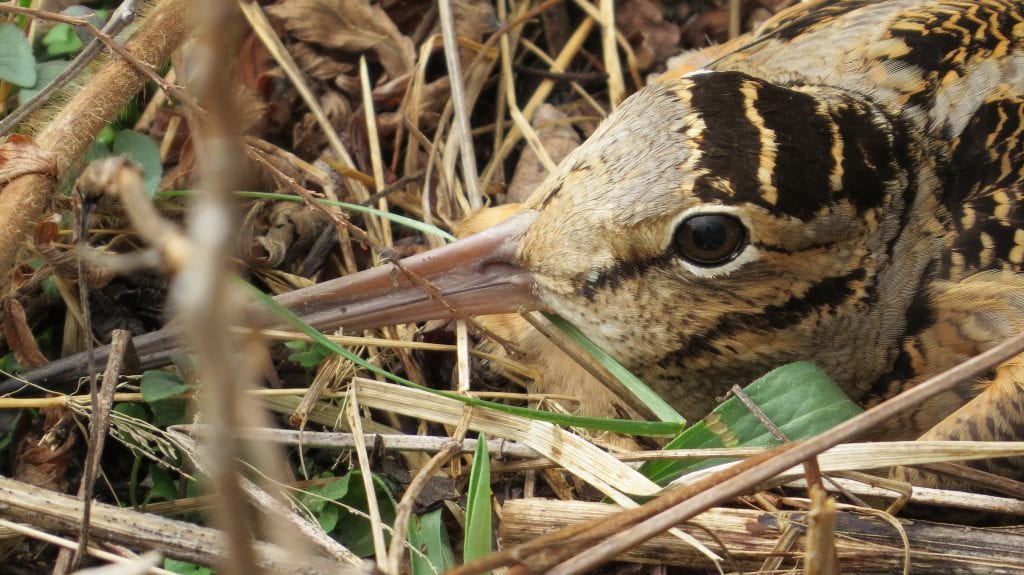
Pam Dudding-Burch
Contributing writer
People often flock to Craig County from the city life towards retirement, and they often express how beautiful the area is as well as the surrounding mountains. It appears that a rare bird is now feeling the same way.
The American Woodcock (AMWO) is a forest-dwelling bird species, yet it is also in the shoreline family, the Scolopacidae. Considered a ‘mysterious’ species, they are not well studied, and gaps in knowledge exist of their life history. They have, however, been spotted in Craig now for over two years.
Brian Murphy and his wife Martha found such a bird nesting on their property in 2016 and have seen a few more since then. The Woodcock has tawny black and gray plumage that blends effortlessly with grasses and woods. Brian Murphy is an Atlas volunteer and a Professor of Fisheries Science at Virginia Tech.
“That was the first American Woodcock nest ever reported for Craig County,” Murphy said. Though the number of birds increased in 2017, he did not track or disturb them.
“In the winter of 2018, we heard a dozen or more birds around the farm doing their mating calls, and saw them perform their amazing flights,” Murphy added. “The mating call sounds like a ‘peent’ to attract a mate which the males repeat until a female responds back.”
He explained that during this ‘flight,’ the Woodcock will fly straight, high up in the air and come down spinning in a spiral with their wings making a unique whistling sound as they descend back to the ground. “They repeat this display alternating between peenting and flying for hours at dawn and dusk,” Brian said. “It’s an amazing thing to hear and watch.”
“This is yet another story where our investment in conservation efforts is successful and why we should all amplify and support like efforts of our neighbors,” Martha shared. “This finding further supports our need for a full county-wide survey of our natural resource and cultural gems here in Craig (and Giles). Our healthy and undisturbed water and mountains will be the key.”
Ashley Peele, the coordinator of the second VA Breeding Bird Atlas, recently published an article on the Woodcock found on Murphy’s property, adding some background information.
“According to the VA Gold Book, the American Woodcock is uncommon to common winter residents in the coastal plain and uncommon winter residents in the Piedmont, Mountains and Valleys,” she wrote. “A quick look at eBird Reports show that birders around Virginia have been reporting male ‘peenting’ calls since late December, and these displays are likely resident or overwintering birds.” She also added that the peak migration of Woodcocks occurs in Virginia from February to March.

Peele shared that, while the American Woodcock is considered an uncommon summer resident, “their cryptic plumage and quiet behavior in the forests mean they may often go undetected.” Information states that their egg laying dates range from February 11 –April 21 (Coastal Plain), March 3 – May 20 (Piedmont) and April 1- May 18 (Mountains and Valleys).
“However, local reports of AMWO nests in Southwestern Virginia show AMWO females consistently laying eggs by late February or early March,” Ashley said. “If this is the case in the mountains, it’s likely that more eastern nesting Woodcock are similarly active by late winter.”
Murphy explained that their increase in the number of birds is directly related to the planting of native grasses and occasionally rejuvenating them with controlled burns throughout their 50+ acres of converted pastures to wildlife habitat.
“Creating un-grazed fields that are a mix of tall cover grass and a more open area will attract these birds to other properties,” he added. It is in the grasses and forest openings the Woodcock’s seem to like best.
“The Woodcocks are doing their mating calls and dances this week and probably into next week too,” the Murphy’s shared. “We are hearing and seeing them on our farm and that of our neighbors during the day and especially at dusk.”
[ad_2]
Source link



